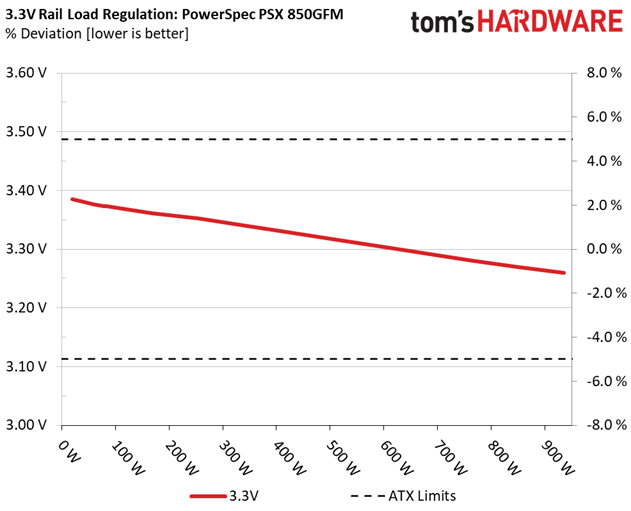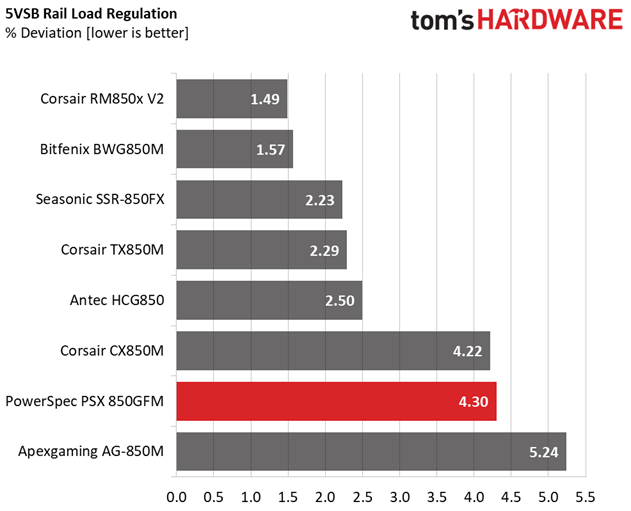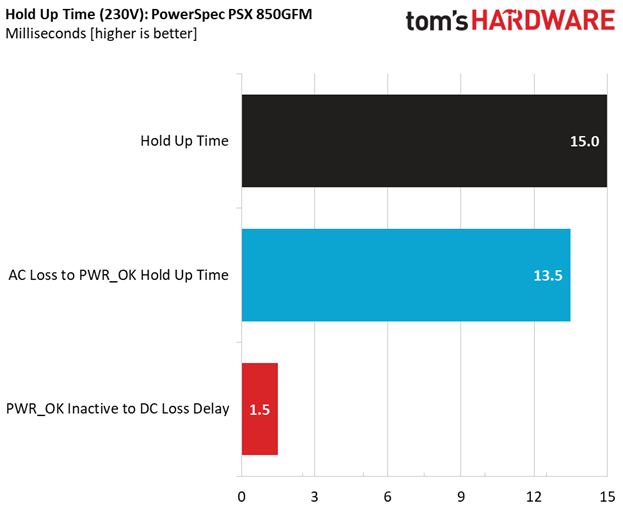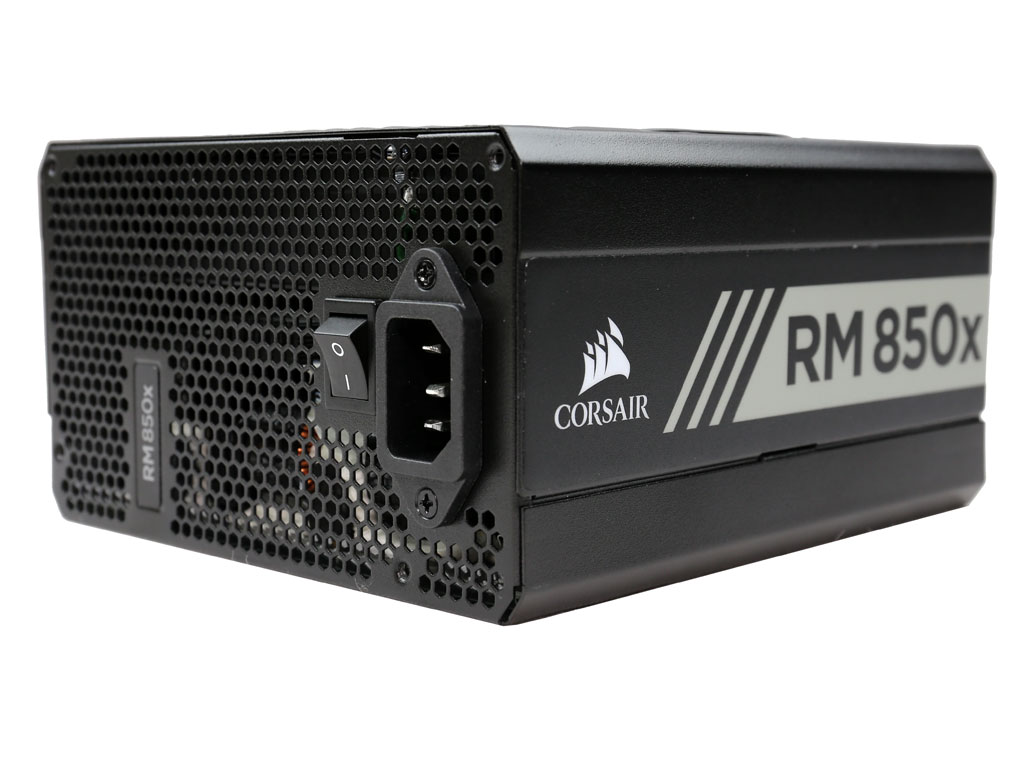PowerSpec PSX 850GFM PSU Review: Micro Center's House Brand Scores A Hit
Why you can trust Tom's Hardware
Load Regulation, Hold-Up Time & Inrush Current
To learn more about our PSU tests and methodology, please check out How We Test Power Supply Units.
Primary Rails And 5VSB Load Regulation
Load Regulation testing is detailed here.








Hold-Up Time
Our hold-up time tests are described in detail here.







Unfortunately, we observed a hold-up time of less than 17ms. At least the power-good signal was accurate.
Inrush Current
For details on our inrush current testing, please click here.


Measured inrush current was very high because of the platform's less-than-optimal design. High Power should fix this as soon as possible.
Load Regulation And Efficiency Measurements
The first set of tests reveals the stability of the voltage rails and the PSX 850GFM’s efficiency. The applied load equals (approximately) 10 to 110 percent of the PSU's maximum load in increments of 10 percentage points.
Get Tom's Hardware's best news and in-depth reviews, straight to your inbox.
We conducted two additional tests. During the first, we stressed the two minor rails (5V and 3.3V) with a high load, while the load at +12V was only 0.1A. This test reveals whether a PSU is compatible with Intel's C6/C7 sleep states or not. In the second test, we determined the maximum load the +12V rail could handle with minimal load on the minor rails.
| Test # | 12V | 5V | 3.3V | 5VSB | DC/AC (Watts) | Efficiency | Fan Speed | PSU Noise | Temps (In/Out) | PF/AC Volts |
|---|---|---|---|---|---|---|---|---|---|---|
| 1 | 5.254A | 1.985A | 1.956A | 1.000A | 84.893 | 86.265% | 655 RPM | 15.4 dB(A) | 40.25°C | 0.970 |
| 12.045V | 5.043V | 3.373V | 5.000V | 98.409 | 44.42°C | 115.26V | ||||
| 2 | 11.512A | 2.980A | 2.945A | 1.204A | 169.388 | 90.680% | 650 RPM | 15.3 dB(A) | 40.77°C | 0.986 |
| 12.030V | 5.033V | 3.361V | 4.984V | 186.798 | 45.54°C | 115.16V | ||||
| 3 | 18.168A | 3.483A | 3.431A | 1.410A | 254.477 | 91.777% | 537 RPM | 12.0 dB(A) | 41.13°C | 0.996 |
| 12.025V | 5.025V | 3.352V | 4.967V | 277.278 | 46.52°C | 115.14V | ||||
| 4 | 24.845A | 3.990A | 3.952A | 1.617A | 339.685 | 91.549% | 537 RPM | 12.0 dB(A) | 41.83°C | 0.995 |
| 12.013V | 5.016V | 3.341V | 4.950V | 371.040 | 48.29°C | 115.02V | ||||
| 5 | 31.202A | 4.996A | 4.957A | 1.825A | 425.000 | 91.095% | 533 RPM | 11.9 dB(A) | 42.16°C | 0.995 |
| 12.002V | 5.006V | 3.329V | 4.933V | 466.546 | 49.39°C | 115.01V | ||||
| 6 | 37.507A | 6.008A | 5.968A | 2.035A | 509.517 | 90.401% | 790 RPM | 19.3 dB(A) | 42.78°C | 0.996 |
| 11.990V | 4.995V | 3.317V | 4.915V | 563.617 | 50.20°C | 114.90V | ||||
| 7 | 43.888A | 7.024A | 6.990A | 2.247A | 594.847 | 89.547% | 987 RPM | 25.6 dB(A) | 43.28°C | 0.997 |
| 11.979V | 4.985V | 3.304V | 4.897V | 664.288 | 51.30°C | 114.76V | ||||
| 8 | 50.285A | 8.044A | 8.021A | 2.461A | 680.184 | 88.742% | 1100 RPM | 29.0 dB(A) | 43.68°C | 0.997 |
| 11.967V | 4.974V | 3.292V | 4.879V | 766.471 | 52.75°C | 114.73V | ||||
| 9 | 57.092A | 8.562A | 8.535A | 2.465A | 765.104 | 87.909% | 1395 RPM | 35.4 dB(A) | 44.43°C | 0.997 |
| 11.956V | 4.964V | 3.281V | 4.871V | 870.337 | 53.86°C | 114.60V | ||||
| 10 | 63.646A | 9.086A | 9.085A | 3.108A | 849.923 | 86.957% | 1390 RPM | 35.4 dB(A) | 45.80°C | 0.997 |
| 11.944V | 4.955V | 3.270V | 4.828V | 977.405 | 55.50°C | 114.56V | ||||
| 11 | 70.809A | 9.101A | 9.110A | 3.115A | 934.693 | 86.021% | 1380 RPM | 35.3 dB(A) | 46.76°C | 0.998 |
| 11.933V | 4.947V | 3.260V | 4.818V | 1086.588 | 56.72°C | 114.42V | ||||
| CL1 | 0.148A | 14.005A | 14.000A | 0.000A | 118.581 | 81.805% | 660 RPM | 15.4 dB(A) | 44.79°C | 0.981 |
| 12.043V | 5.014V | 3.327V | 5.074V | 144.956 | 53.63°C | 115.19V | ||||
| CL2 | 70.846A | 1.002A | 1.002A | 1.000A | 859.269 | 87.555% | 1390 RPM | 35.4 dB(A) | 45.51°C | 0.997 |
| 11.942V | 4.979V | 3.302V | 4.929V | 981.407 | 55.18°C | 114.56V |
Load regulation on the 12V and 5V rails was decent. However, deviations exceeded 3% on the 3.3V rail and 4% at 5VSB. Obviously, load regulation isn't one of the PSX 850GFM's strong points. It's not especially bad either. But the competition in this capacity/price range is tough, making every percentage point count.
Efficiency-wise, the PSX 850GFM easily satisfied the 80 PLUS Gold spec's requirements with 20% and 50% loads. It almost reached 87% under full load, too, despite our grueling 46°C ambient test temperature.
The fan's ramp looks really weird: from 30% load through our mid-load test, it spun slower than what we observed under light loads. Apparently, someone messed with our sample's fan profile. In a worst-case scenario, the fan's speed remained moderate, so noise was kept fairly low.
MORE: Best Power Supplies
MORE: How We Test Power Supplies
MORE: All Power Supply Content
Current page: Load Regulation, Hold-Up Time & Inrush Current
Prev Page Teardown & Component Analysis Next Page Efficiency, Temperature & Noise
Aris Mpitziopoulos is a contributing editor at Tom's Hardware, covering PSUs.
-
AnimeMania In the video, you should have turned on the PSU and shown all the RGB lighting choices.Reply -
pureblackfire2 I wouldn't consider this even if it's cheap. for non enthusiasts it's far from idiot proof enough to recommend. for power users they'd obviously want something better. meh.Reply -
Rexper Low quality sleeve bearing fan without Over Temperature Protection or Fan Failure Protection? No thanks.Reply


